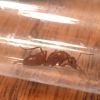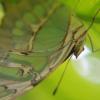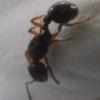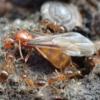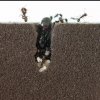1. Location of collection: Gainesville, FL
2. Date of collection: April 13, 2017 1:30 PM, last rainstorm was about 1 week ago (though it is always humid and hot here!)
3. Habitat of collection: I found this dealate resting (not walking or moving) about two feet up from the ground on the vertical brick wall of my house. The area is surrounded by houses with small yards and some trees.
4. Length: 9.5 mm (3/8")
5. Coloration: Bright red all over, mostly smooth texture.
6. Distinguishing characteristics: 0-1 petiole node (unsure if the thing I saw is a petiole because it looks different from the spiky petioles on my Solenopsis queens), no spines, no clubs on antennae




